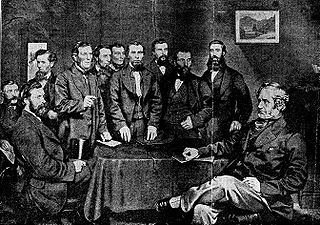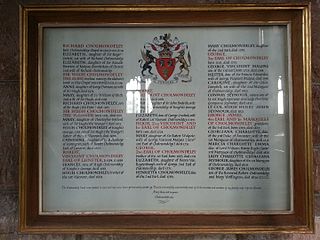
Baron Newborough is a title that has been created twice in the Peerage of Ireland; both titles are extant. The first creation came in 1716 in favour of George Cholmondeley, later 2nd Earl of Cholmondeley. See Marquess of Cholmondeley for further history of this creation.

Baron Penrhyn is a title that has been created twice. The first creation came in the Peerage of Ireland in 1783 in favour of Richard Pennant, who had previously served as a Member of Parliament for Petersfield and Liverpool. This creation became extinct on his death in 1808. The next creation came in 1866 in the Peerage of the United Kingdom when the Conservative politician Edward Douglas-Pennant was created Baron Penrhyn, of Llandegai in the County of Carnarvon. He had previously represented Carnarvon in the House of Commons and also served as Lord Lieutenant of Caernarvonshire. He was granted the estate of his father-in-law on the condition that he accepted his wife's maiden name, Pennant. Lord Penrhyn was the younger brother of The 17th Earl of Morton. In 1833 he had married Juliana Isabella Mary Pennant, eldest daughter and co-heiress of George Hay Dawkins-Pennant of Penrhyn Castle and in 1841 he assumed by Royal licence the additional surname of Pennant.
This is a list of people who served as Lord Lieutenant of Merionethshire. After 1762, all Lord Lieutenants were also Custos Rotulorum of Merionethshire. The office was abolished on 31 March 1974, and the area is now covered by the Lord Lieutenant of Gwynedd and Lord Lieutenant of Clwyd.

Sir John Wynn, 1st Baronet, was a Welsh baronet, Member of Parliament and antiquary.
This is a list of people who have served as Lord Lieutenant of Flintshire. Since 1802, all Lord Lieutenants have also been Custos Rotulorum of Flintshire. The office was abolished on 31 March 1974, and was replaced by the Lord Lieutenant of Clwyd.
The following is a list of people who have held the title of Lord Lieutenant of Montgomeryshire. After 1761, all Lord Lieutenants were also Custos Rotulorum of Montgomeryshire. The office was abolished on 31 March 1974 and replaced by the Lord Lieutenant of Powys, with Deputy Lieutenants for Montgomeryshire.
This is an incomplete list of people who served as Lord Lieutenant of Denbighshire in Wales. After 1733, all Lord Lieutenants were also Custos Rotulorum of Denbighshire. The office was abolished on 31 March 1974, being replaced by the Lord Lieutenant of Clwyd.
This is a list of people who have served as Custos Rotulorum of Caernarvonshire.

Edward Gordon Douglas-Pennant, 1st Baron Penrhyn, was a Scottish landowner in Wales and Jamaica, and a Conservative Party politician. He played a major part in the development of the Welsh slate industry.

George Cholmondeley, 2nd Earl of Cholmondeley, PC, FRS, styled The Honourable from birth until 1715 and then known as Lord Newborough to 1725, was an English soldier. Cholmondeley was the second son of Robert Cholmondeley, 1st Viscount Cholmondeley, and Elizabeth Cradock. Hugh Cholmondeley, 1st Earl of Cholmondeley, was his elder brother. He was educated at Westminster School and Christ Church, Oxford. Cholmondeley supported the claim of William of Orange and Mary to the English throne and after their accession he was appointed a Groom of the Bedchamber.
The Williams, later Williams-Bulkeley Baronetcy, of Penrhyn in the County of Caernarvon, is a title in the Baronetage of England. It was created on 17 June 1661 for Griffith Williams. He had already been granted a baronetcy by Oliver Cromwell in 1658. The second Baronet represented both Caernarvonshire and Caernarvon in the House of Commons. The eighth Baronet sat as Member of Parliament for Beaumaris while the ninth Baronet represented Caernarvonshire and Beaumaris. The tenth Baronet was Member of Parliament for Beaumaris, Anglesey and Flint Boroughs and served as Lord Lieutenant of Caernarvonshire. In 1826 he assumed by Royal licence the additional surname of Bulkeley on succeeding to the estates of Thomas James Bulkeley, 7th Viscount Bulkeley. The twelfth and thirteenth Baronets were both Lord Lieutenant of Anglesey while the latter was also Lord Lieutenant of Gwynedd. The family seat is Baron Hill, Anglesey. Arms of Williams of Penrhyn: Gules, a chevron ermine between three Saxon's heads in profile couped proper.
This article is about the particular significance of the year 1827 to Wales and its people.
This article is about the particular significance of the year 1796 to Wales and its people.
This article is about the particular significance of the year 1785 to Wales and its people.
This article is about the particular significance of the year 1783 to Wales and its people.
This article is about the particular significance of the year 1702 to Wales and its people.
Events from the year 1752 in Wales.
Events from the year 1750 in Wales.
This article is about the particular significance of the year 1736 to Wales and its people.




